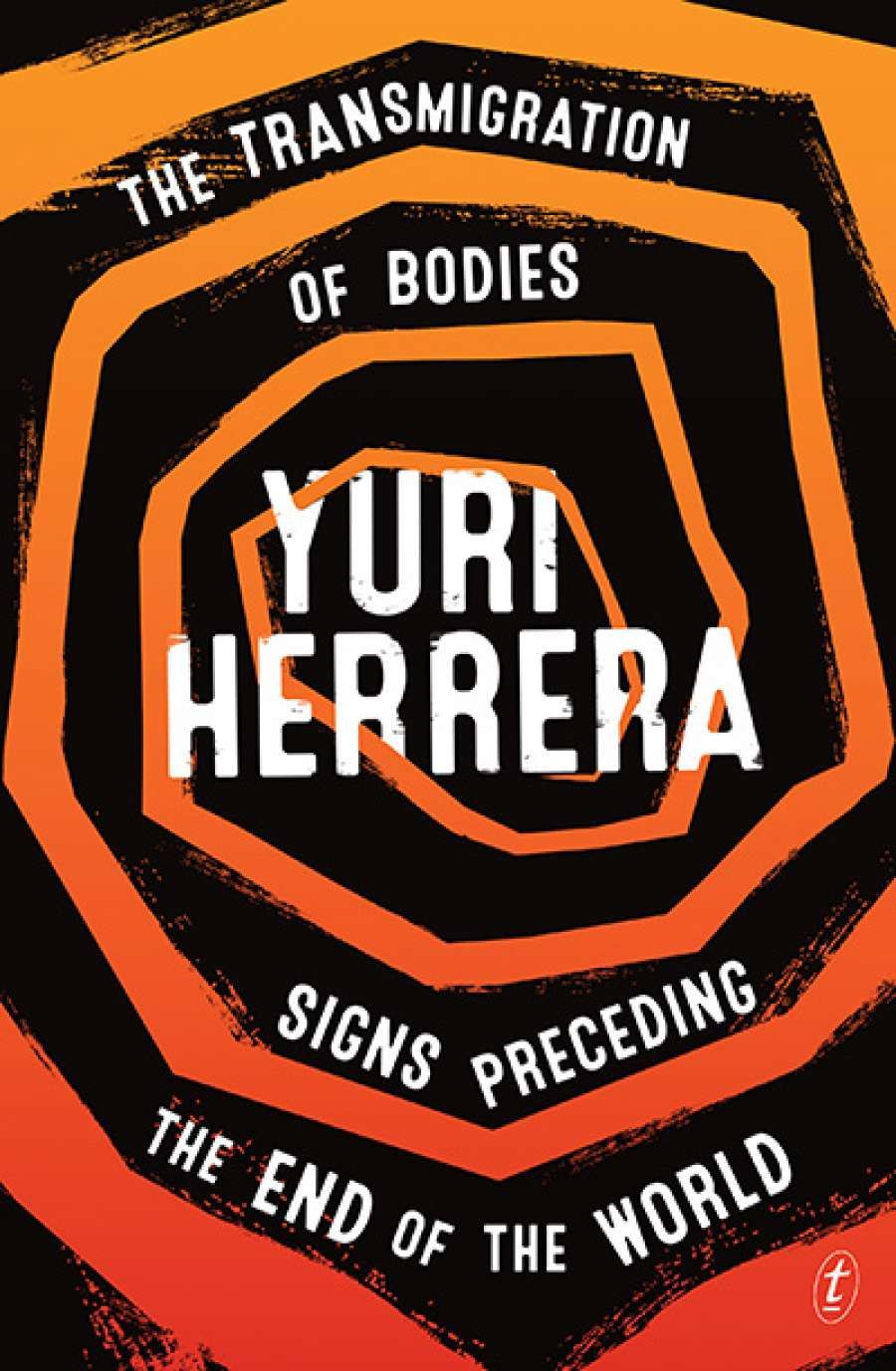
- Free Article: No
- Contents Category: Fiction
- Custom Article Title: Gabriel García Ochoa reviews 'The Transmigration of Bodies and Signs Preceding the End of the World' by Yuri Herrera, translated by Lisa Dillman
- Custom Highlight Text:
Mictlán, the underworld of Aztec mythology, is divided into nine regions, like Dante’s Inferno. Yuri Herrera’s novella, Signs Preceding the End of the World, opens with ...
- Book 1 Title: The Transmigration of Bodies and Signs Preceding the End of the World
- Book 1 Biblio: Text Publishing $29.99 pb, 240 pp, 9781925498240
Signs Preceding the End of the World follows this writing style. Makina travels ‘North’ to a different country, a place of ‘Anglos’ in search of her lost brother, who went there to find his fortune. She can’t afford to get caught. She has to cross the border. The Mexican migrant story is there, blatantly obvious, and yet, the words ‘Mexico’, ‘United States’, ‘English’, ‘Spanish’, or ‘Wetback’ are never used. Like the Styx, like the Apanohuacalhuia of Aztec folklore, a river marks the border to the realm Makina is venturing into, but hers is a nameless tributary. This lack of specificity, this ‘absence’, has an extraordinary effect on the text. Herrera’s novella becomes a micro-epic, at once clear and ambiguous, transcultural, localised but applicable to countless sagas of migration across the globe. In scarcely more than one hundred pages, it encapsulates a story that is much bigger than itself
Herrera’s other novella in this volume, The Transmigration of Bodies, is not about a journey to the underworld, but through it. The characters are already there. Scarcely two pages into the story, we find a swarm of harmless-looking mosquitos drinking from a puddle of blood. They are the carriers of the plague that has decimated the unnamed city where the story takes place.
The main character, the Redeemer, is a diplomat of the demi-monde. Words are his capital, cudgel, and code to the city’s many secrets. He uses them to seduce beautiful women and to bring gangster feuds to a peaceful resolution. The Redeemer has been hired to resolve a dispute between two powerful warring families. Each family holds hostage the corpse of a member of the opposing clan. The Redeemer has to negotiate the exchange of bodies without triggering an escalation of violence in the already apocalyptic setting.
The plot serves as a good excuse to show the state of a once bustling metropolis that has run out of facemasks. Drugstores have been looted and vandalised. The army roams the empty streets imposing ‘order’, which, in typical Latin American fashion, means they are abusing their authority. The Redeemer goes from one place to the next in search of clues, risking his life through possible exposure to the mosquito-borne disease, and other less tangible but equally deadly epidemics (corruption, violence, insecurity). Again, Mexico City is never mentioned in the text, but there is a strong sense that this is where the story takes place, perhaps because the novella’s dystopian setting appears to reference the swine flu pandemic of 2009, which, unprecedentedly, managed to clear the streets of the biggest city in the world.
 Yuri HerreraLisa Dillman is a seasoned translator. She has translated more than a dozen novels by authors from Spain, Argentina, Nicaragua, Guatemala, and Mexico, including Sabina Berman and Eduardo Halfon. This year she won the University of Rochester’s Best Translated Book Award for Signs Preceding the End of the World. It is easy to see why.
Yuri HerreraLisa Dillman is a seasoned translator. She has translated more than a dozen novels by authors from Spain, Argentina, Nicaragua, Guatemala, and Mexico, including Sabina Berman and Eduardo Halfon. This year she won the University of Rochester’s Best Translated Book Award for Signs Preceding the End of the World. It is easy to see why.
Dillman’s translations are nothing less than heroic. Herrera’s writing feels foreign, even in Spanish. Not because it is impenetrable (it is quite accessible, actually), but because his originality defamiliarises language. He is terribly inventive; terribly, because prose like his has to be a pleasure and a nightmare to translate. Herrera peppers his sentences with Mexican slang, Arabisms, neologisms. There are French and English portmanteaus, a constant shift in register from formal to informal, and back again. The subject matter of his texts is serious, but the prose is playful. Words fluctuate, adjectives are nominalised, nouns verbalised.
Herrera’s novellas are transgressive. In their plots, their use of language, they cross boundaries, and in that transition, that crossing, they create something new. As the unidentified narrator of Signs Preceding the End of the World tells us, ‘Using in one tongue the word for a thing in the other makes the attributes of both resound: if you say Give me fire when they say Give me a light, what is not to be learned about fire, light and the act of giving?’


Comments powered by CComment